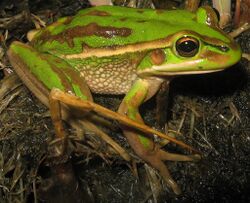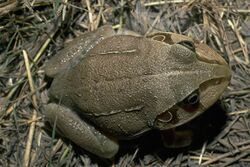Biology:Ranoidea (genus)
| Ranoidea | |
|---|---|

| |
| Ranoidea aurea, the type species | |
| Scientific classification | |
| Domain: | Eukaryota |
| Kingdom: | Animalia |
| Phylum: | Chordata |
| Class: | Amphibia |
| Order: | Anura |
| Family: | Hylidae |
| Subfamily: | Pelodryadinae |
| Genus: | Ranoidea (Tschudi, 1838) |
| Type species | |
| Ranoidea jacksoniensis (Tschudi, 1838)
| |
| Synonyms[1] | |
|
List
| |
Ranoidea is a genus of frogs in the subfamily Pelodryadinae. They are found in Australia, New Guinea, and two nearby groups of islands: the Maluku Islands, and the Louisiade Archipelago.[1] The circumscription of this taxon is still controversial.

Taxonomy
Species in this genus were until recently placed in the then-paraphyletic genus Litoria; many of them had been placed in even larger Hyla before. However, in 2016 Duellman and colleagues split Litoria into several genera.[1][2] The systematic and taxonomic conclusions based on Duellman et al.[2] should be treated with caution, because 78.9% of individuals (397/503) used in the concatenated analyses had less than half of the gene sequences available for the 19 genes used. Missing data can be problematic in phylogenetic analyses (e.g.[3][4][5][6]) and lead to erroneous conclusions about systematic relationships. Additionally, there is no mention of checking for base-composition bias amongst taxa (non-stationarity), which can also lead to incorrect tree phylogenies (e.g.[7][8]). The species now in Ranoidea were placed in the genus Dryopsophus. However, the oldest available name for these species is Ranoidea.[1] These changes are not yet widely recognized or accepted,[9] and the AmphibiaWeb continues to recognize Litoria in the older, broad sense.[10] The AmphibiaWeb also recognizes Cyclorana,[10] a position that, without additional amendments, renders Ranoidea paraphyletic; it may be treated as a subgenus.[1]
Description and ecology
The pupil is horizontally elliptical, and the palpebral membrane is unpigmented. Many species have tadpoles that develop in mountain streams and have enlarged ventral mouths.[2] However, tadpoles of subgenus Cyclorana are adapted to standing water and are often found in temporary water bodies.[11]
Species
The following species are recognised in the genus Ranoidea:[1]
Although currently listed as incertae sedis, it is expected that "Ranoidea papua" (Van Kampen, 1909) will also be included in the genus once its range has been properly delimited.
References
- ↑ 1.0 1.1 1.2 1.3 1.4 1.5 Frost, Darrel R. (2022). "Ranoidea Tschudi, 1838". Amphibian Species of the World: An Online Reference. Version 6.1. American Museum of Natural History. https://amphibiansoftheworld.amnh.org/Amphibia/Anura/Hylidae/Pelodryadinae/Ranoidea. Retrieved 11 November 2022.
- ↑ 2.0 2.1 2.2 2.3 Duellman, William E.; Marion, Angela B.; Hedges, S. Blair (19 April 2016). "Phylogenetics, classification, and biogeography of the treefrogs (Amphibia: Anura: Arboranae)". Zootaxa 4104 (1): 1–109. doi:10.11646/zootaxa.4104.1.1. PMID 27394762.
- ↑ Simmons, M.P. 2012. Misleading results of likelihood‐based phylogenetic analyses in the presence of missing data. Cladistics 28(2): 208-222. DOI: 10.1111/j.1096-0031.2011.00375.x)
- ↑ Dunn, K.A., McEachran, J.D., & Honeycutt, R.L. 2003. Molecular phylogenetics of myliobatiform fishes (Chondrichthyes: Myliobatiformes), with comments on the effects of missing data on parsimony and likelihood. Molecular Phylogenetics and Evolution 27(2): 259-270. DOI: 10.1016/S1055-7903(02)00442-6
- ↑ Kearney, M. 2002. Fragmentary taxa, missing data, and ambiguity: mistaken assumptions and conclusions. Systematic biology 51(2): 369-381. DOI:10.1080/10635150252899824
- ↑ Xi, Z., Liu, L., & Davis, C.C. 2016. The impact of missing data on species tree estimation. Molecular Biology and Evolution 33(3): 838-860. DOI: 10.1093/molbev/msv266
- ↑ Jermiin, L.S., Ho, S.Y., Ababneh, F., Robinson, J., & Larkum, A.W. 2004. The biasing effect of compositional heterogeneity on phylogenetic estimates may be underestimated. Systematic biology 53(4): 638-643. DOI: 10.1080/10635150490468648
- ↑ Song, H., Sheffield, N.C., Cameron, S.L., Miller, K.B., & Whiting, M.F. 2010. When phylogenetic assumptions are violated: base compositional heterogeneity and among‐site rate variation in beetle mitochondrial phylogenomics. Systematic Entomology 35:3, 429-448. DOI: 10.1111/j.1365-3113.2009.00517.x
- ↑ McDonald, K.R., Rowley, J.J., Richards, S.J., & Frankham, G.J. (2016). A new species of treefrog (Litoria) from Cape York Peninsula, Australia. Zootaxa 4171(1): 153-169. DOI: 10.11646/zootaxa.4171.1.6
- ↑ 10.0 10.1 "Hylidae". AmphibiaWeb. University of California, Berkeley. 2018. http://www.amphibiaweb.org/lists/Hylidae.shtml. Retrieved 18 June 2018.
- ↑ Van Buskirk, J. (2009). "Getting in shape: adaptation and phylogenetic inertia in morphology of Australian anuran larvae". Journal of Evolutionary Biology 22 (6): 1326–1337. doi:10.1111/j.1420-9101.2009.01750.x. PMID 19457143.
Wikidata ☰ Q24813105 entry
 |

